« June 2014 |
Main
| August 2014 »
 July 31, 2014 | Best of JM: Raking it in. Autumn Leaves Pt. 2
July 31, 2014 | Best of JM: Raking it in. Autumn Leaves Pt. 2
Enjoy the popular archive material below.
From July 12, 2012 | Raking it in. Autumn Leaves Pt. 2.
We last looked at the jazz classic "Autumn Leaves" Part 1 for the opportunity to take two simple one-octave scale patterns up the neck (E dorian/minor and G major) to begin to craft effective improvisation.
 
Hopefully, you took the time to work the FFcP patterns for these into your fingers, and feel some degree of comfort playing out of open position. It's great if you have some backing tracks (or an accompanying instrumentalist) to start to break out of the patterns and experiment with some soloing. This is where the rubber meets the road with the FFcP exercises. Out of the lab and into the field...
Scales vs. Licks
We've talked about two distinct approaches to improvisation, one using the framework of scales, the other using licks or motives from other songs and moving them around the fretboard. There's a viable school of thought that spending time transcribing and analyzing other artists' work to get into their heads for these sound nuggets, and begin the process of recreating your own licks. We think both approaches are necessary in optimal creativity. The scale approach can give you efficient, map like access to the "right" notes, but at the risk of sounding sterile or clinical. The "lick" approach gives great material, too, but leaves you dependent on others for material, and can leave you stuck endlessly repeating the same material.
We've worked up something that's a little of both, and cover it in the book "Getting Into Jazz Mandolin." For example, the "ii V7 I" patterns roll out the classic cadence and offer increasingly complex licks based on the scale. Pardon the hard sell, but this is a compelling reason alone to acquire the book, since it covers all four FFcP patterns in both major and minor keys. For now, we'll give you a taste, and you can even apply this material to "Autumn Leaves."
Take a moment to play through these, and see how they might be your own personal starting point to jamming with this terrific tune.
Download two page PDF:  E Minor ii7b5 V7 i 4th FFcP E Minor ii7b5 V7 i 4th FFcP
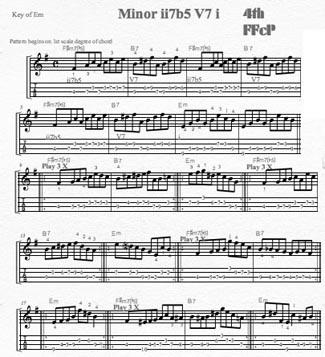
Now see what you can do with these measures for your own experimenting. Note the progression of starting notes in each of the four sections of the exercise--it helps you get away from always beginning your solo with the root of the chord.
You might even want to dig up an online backing track:
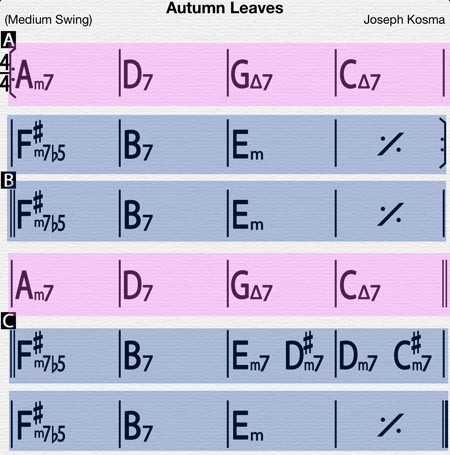
Further:
Four Finger Closed Position FFcP
Dorian/Minor FFcP Studies
ii7b5 V7 i Minor Patterns
Improvisation Techniques
New to JazzMando: Dorian/Minor FFcP!
Minor Blues: Fresh patterns
Posted by Ted at 1:20 PM
 July 24, 2014 | Best of JM: Raking it in. Autumn Leaves Pt. 1
July 24, 2014 | Best of JM: Raking it in. Autumn Leaves Pt. 1
Enjoy the popular archive material below.
From July 5, 2012 | Raking it in. Autumn Leaves Pt. 1.
We love music theory. It's a great tool for looking under the hood and exploiting beneficial shortcuts to creating and understanding music. We use it in even in our "mechanical" approach to the fretboard, our movable FFcP system. You've probably noticed we've inserted intervals (3rds, 4ths), some arpeggiated chords, and some passing/approach tone drills in the system. It's finger coordination but if you've been listening while you play, there's some heavy subconscious aural training going on, too.
Still, theory is no good if you don't apply it. We want to go out of the lab now and into the field with the jazz standard, Autumn Leaves and show you a simple way to apply two FFcP patterns to this classic.
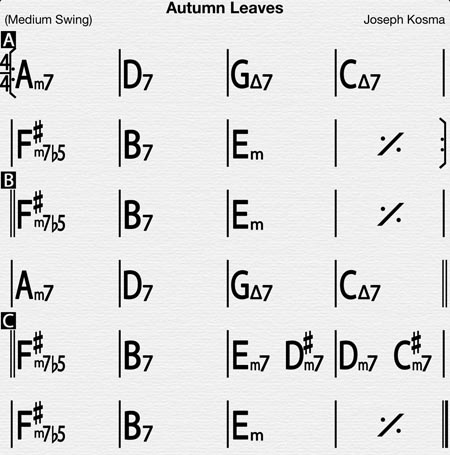
Without altering with any sophisticated substitutions, you can trim this down to just two patterns based on two keys. The whole song is in only two keys, E minor, and it's relative G major. We'll draw from two finger patterns to come up with the one-octave field of notes to harvest. The idea is you can go back to the Dorian/Minor FFcP drills, pick up the 4th FFcP in D minor and move it up a couple frets to E minor. Your 4th finger starts the pattern on the 9th fret.

Before you start playing the tune, drill the 4th FFcP in this key for awhile. Take a few days even, until you are comfortable with it.

The next thing would be to take a 2nd FFcP incarnation of the G scale by basing the one octave field with the second finger on the 5th fret. Note, you aren't moving hardly at all from the E minor. Work it similarly until it becomes second nature, reviewing what we created for Bb in the FFcP Introduction series.
When you feel solid on this you're ready to start applying the new found scale intuitive proficiencies to the actual song. Below is a color coded interpretation of where you would use the FFcP patterns, the pink shows where you'd use G major, the blue would be E minor (dorian).

We don't want to go too deep in the semantics of raised 6th and 7th in the minor scale, other than to say when you're using the Dominant Function chord B7, you'll probably be rasing the D to a D#. This is where the chord/arpeggio part of the drill can help out. Trust your ear--it will tell you what to do.
This is where the rubber meets the road, theory to real life. We're still at a point where if this is all you do, grab scales and play drills, your improv will sound like scales and drills. It's a starting point.
Next session, we'll look at applying the FFcP to some licks.
Further:
Four Finger Closed Position FFcP
Dorian/Minor FFcP Studies
ii7b5 V7 i Minor Patterns
Improvisation Techniques
New to JazzMando: Dorian/Minor FFcP!
Minor Blues: Fresh patterns
Posted by Ted at 4:01 PM
 July 17, 2014 | Best of JM: Making sense. More than five senses?
July 17, 2014 | Best of JM: Making sense. More than five senses?
Enjoy the popular archive material below.
From June 11, 2010 | Making sense. More than five senses?.
We all grow up with the notion that we have five senses. Sight, hearing, taste, smell, touch. There is always an added ethereal reference to a sixth sense, tons of movies and books have been written about this tantalizing phenomenon, but what many may not be aware of, physiologists have even expanded these senses to as many as nine to twenty-two, although categories can blur, and some of them involve non-human ones, for example a bat's radar (echolocation).
The additional human ones are interesting. You have balance and acceleration, also known as equilibrioception whose organ is the vestibular labyrinthine system found in both of the inner ears. Some of us are good, some are lousy, as failed experiences with pole vaulting in childhood can reveal. You also have the thermoceptors in the skin yielding a sense of temperature, different from the homeostatic ones in the brain (hypothalamus) which provide feedback on internal body temperature. Direction, magnetoception (or magnetoreception) is the ability to detect the direction one is facing based on the Earth's magnetic field. Directional awareness is most commonly observed in birds, though it is also present to a limited extent in humans. If you've ever arrived at a destination on a cloudy day or at night, sometimes you still have a feeling where north is, devoid of the sun.
Nociception or physiological pain signals near-damage or damage to tissue. The three types of pain receptors are cutaneous (skin), somatic (joints and bones) and visceral (body organs). Of course these are important signals for a player to recognize; pain is a message not to ignore.
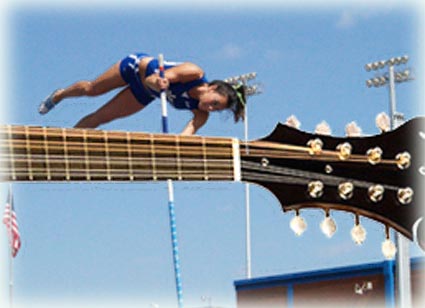
Also, relevant to mandolin playing, proprioception or Kinesthetic sense, provides the parietal cortex of the brain with information on the relative positions of the parts of the body. The notion that if you close your eyes, with this sense you can touch your index finger to your nose. You use this when taking your eyes off the fingerboard, and developing an important kinesthetic sense of finger and pick position. It's more than just touch, it's a fretboard GPS.
Others that aren't commonly covered in physiological studies but are very important to playing are senses involving rhythm, pitch, harmony, and melodic distinction. Certainly, we all have varying degrees of abilities here, some may have perfect pitch, the awareness of A440 or any other pitch at any time. Some are blessed with good relative pitch and while the former is something you are born with, the latter is one you can develop over time.
Sense of rhythm should be included, too. You know musicians who have developed incredible time; some seem to take this gift to new dimensions. There's nothing like playing with a good drummer with a finely honed awareness of time.
Some have a knack for hearing chords, some are better at melody. It's a vertical verses horizontal sense, and it's interesting how some musicians are all about the chord and harmonic progression (likely attracted to jazz) and some can memorize and repeat melody in vivid and intricate detail. Those who can internalizes lengthy, complex phrases are probably highly attracted to the intricacies of Celtic or Balkan music and other sophisticated folk genres.
We call it "playing." It should be that. You can get the best enjoyment out of discipline and developing these additional senses through exercises and listening, but be aware that humans are as different and individual as snowflakes, and we will each have different access to skills within the palate of senses. Work on weaknesses certainly, but at the same time, recognize and bask in the aptitudes you are blessed with as a player, the gifts God gave you.
We're going to go work on ours with a little FFcP now...
Further:
Fingers, Ears, Brain
Four Finger Closed Position FFcP
Chords in the fingers. Chords in the head.
Dr. Mao: Four Exercises to Sharpen Your Brain.
Starting, Stopping, and That Stuff in the Middle.
Posted by Ted at 6:20 AM
 July 10, 2014 | Online rebroadcast of Mike Marshall's ArtistWorks workshop
July 10, 2014 | Online rebroadcast of Mike Marshall's ArtistWorks workshop
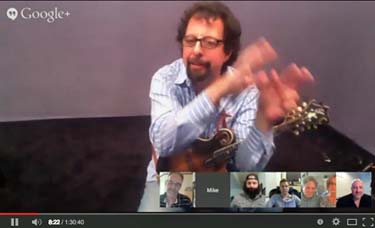
Here you have it! The successful video session of last night's Mike Marshall Mando Magic with a click of your mouse. Moderated by Mandolin Cafe admin Scott Tichenor, you get a sample what it's like to partake in specialized group lesson from the convenience of your computer, literally across the planet.
Enjoy!
View Video Link:The REAL Mando Magic with Mike Marshall
Limited offer: Get 20% off an ArtistWorks subscription by entering MANDOMAGIC at check-out. Information
Posted by Ted at 10:31 AM
 July 3, 2014 | Jazz Advice: The Real Book Player
July 3, 2014 | Jazz Advice: The Real Book Player
An interesting article on the Jazz Advice blog was recently brought to our attention by one of our Australian readers, Professor David Lewis. Titled "Why You Shouldn't Be a Real Book Player," it takes a critical look at the dangers of becoming too dependent on "Real Book" use, the collection of jazz standards many players depend on at gigs and practice. The thrust is players get tied to a print umbilical cord, pun unintentional. We've witnessed this in pedagogy, the student jazzer that can't wean him/herself from the music stand, eyes perpetually glued to the security of staff and chord symbols.
Read article: Why You Shouldn't Be a Real Book Player
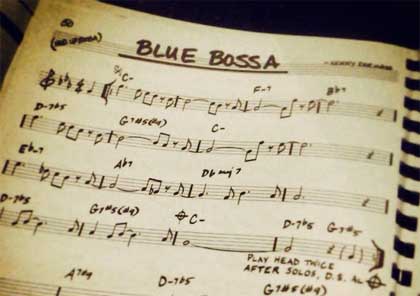
The author has merit to his argument, though we fear a baby-out-with-the-bathwater move.
Certainly, the Realbook should be considered notes to a performance, and not the script. If the page isn't considered a jumping off point, but a final interpretation, it becomes counter productive. However, we would argue players have three different approaches to internalizing music.
Kinetic: The scale exercises we do are great for absorbing melodic pathways. They aren't the journey, but they are a toolbox to fretboard prowess and accessibility. They are a means, not an end, and the skeleton of the leadsheet gives an immediate interpretation to a classic song that can be drilled over and over to free the intellect up to add flesh. Fingers first, brain, later.
Aural: Some learn better through hearing the tune. Nuance is captured and retained, and they are better equipped to live in the world of rote and sound. Not all of us have that ability, however.
Visual: A map internalized through the visual cortex is best for many. Some have to see words before they can hear them, and music can be the same way. SEE the chord. SEE the triad in the staff. SEE the accidental. This does have a disadvantage, absent the nuance of rhythm, tone color, and feel. Still, it can be a start, and in an ensemble situation, the players can begin and end a song with something mutual, organized, and uniform.
Though most will lean heavier in one of the three directions, it's best to incorporate all three in developing playing skills. A heavier kinetic base frees the brain to inject intellect and later, aesthetic. The visual offers community participation more effectively. Still, at the end it is music after all, and it must reign in the world of timbre and rhythm, or you end up with nothing but a stark audio crossword puzzle.
Strengths and Weaknesses of Realbook Playing:
Pro:
Instant access to form and melody.
Uniformity. Playing the head in an ensemble context uniformly.
Visual analysis of the harmonic framework of the song.
Breadth of repertoire, time to learn more songs.
Con:
Trapped in the sheet music--inescapable safety line.
Player's creativity limited, less likely to interact with rhythmic and harmonic shifts of the others.
Dependent on visual, you don't use ears to explore.
You are the drama of the script, not the character of the music.
Not learning by ear denies opportunity to develop your ear.
Purchase: Realbook
Further:
How we learn
Approaching Improvisation
The Joy of Mandolinning
Again. Fingers/Ears/Brain
Inner Game of Tennis
Posted by Ted at 10:55 AM

Disclaimer: In the 'Information Age' of the 21st Century,
any fool with a computer, a modem, and an idea can
become a self-professed 'expert." This site does not
come equipped with 'discernment.'
|



